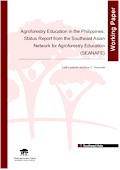| Working Paper Series |
 |
|
| Title | Agroforestry education in the Philippines: Status report from the Southeast Asian Network for Agroforestry Education (SEANAFE) | | Author | Leila Landicho and Jesus C. Fernandez | | Year | 2010 | | Publisher | World Agroforestry Centre - ICRAF, SEA Regional Office | | City of Publication | Bogor, Indonesia | | Series Number | Working Paper no 96 | | Number of Pages | 23 | | Call Number | WP0128-10 | | Keywords | agroforestry education, status, assessment, Philippines |
|
| Abstract: |
| This paper is based on the survey data collected by the Southeast Asian Network for Agroforestry Education (SEANAFE) from 22 out of 34 member institutions of the Philippine Agroforestry Education and Research Network (PAFERN) between 2007 and 2008. The survey was also intended to help PAFERN and SEANAFE identify future projects and activities relevant to accomplishing SEANAFE’s vision-mission of improving livelihoods and ensuring sustainable rural development in the region through improved agroforestry education.
The survey results indicated a significant growth in agroforestry education in the Philippines since 1976 because of the perceived need to continuously produce manpower to help rehabilitate the upland areas. Currently, there are already 34 academic institutions offering different types of agroforestry programs in the country. These programs include BS Agriculture major in Agroforestry (BSA-AF), BS Forestry major in Agroforestry (BSF-AF), BS Agroforestry (BSAF), BS Agroforestry Entrepreneurship (BSAE), terminal and ladderized Diploma/Certificate in Agroforestry, and Master of Science in Agroforestry (MSAF).
The past two decades have also shown considerable improvements in the qualifications of teaching staff in academic institutions offering BSAF program. Teaching materials, though limited in number, were always made available to students. The Policy, Standards and Guidelines (PSG) for BSAF issued by the Philippine Commission on Higher Education (CHED) in 2006 has helped standardize the curriculum for the said program among institutions surveyed. Nevertheless, agroforestry courses were still being taught in other related programs. While interest to conduct research and extension activities among faculty was increasing, opportunities were nevertheless limited for them due to
resource constraints and heavy workload. On the other hand, students’ interest to pursue a BSAF degree was observed to be declining due to limited job prospects after graduation. Incidents of drop out among BSAF students were also occurring in most academic institutions because of financial constraints.
There is a need for academic institutions and agroforestry networks, such as PAFERN and the National Association of Agroforesters of the Philippines (NAAP), to establish more innovative recruitment, curricular review, and job placement programs to make agroforestry education more attractive to students and prospective employers. PAFERN and NAAP should also take the lead to lobby with the local government units (LGUs) to create core positions for agroforestry graduates and provide financial support to implement collaborative agroforestry research and extension programs for
rural development with learning institutions. A database of essential agroforestry teaching materials and facilities available in the country would facilitate effective and efficient sharing of the same among the learning institutions and ensure the quality of teaching agroforestry to students. |
|